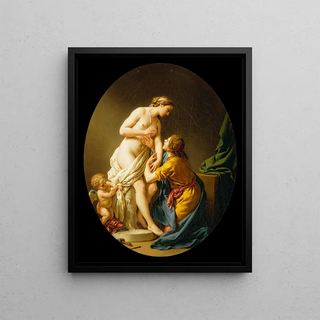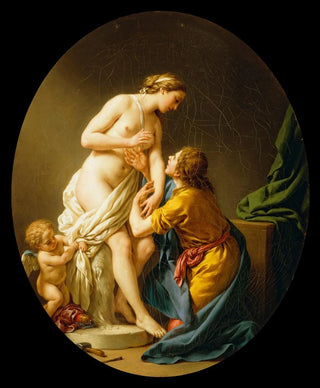Art print | Pygmalion and Galatea - Louis-Jean-François Lagrenée


View from behind

Frame (optional)
Pygmalion and Galatea Art print - Louis-Jean-François Lagrenée – Captivating introduction
In the enchanting world of neoclassicism, the "Pygmalion and Galatea" art print by Louis-Jean-François Lagrenée stands out for its ability to capture the very essence of ancient myths while reinterpreting them with a sensitivity unique to its era. This canvas, which evokes the famous myth of Pygmalion, sculptor who brought his creation, Galatea, to life, embodies not only a story of love and passion but also a reflection on beauty and art. Through this work, Lagrenée invites us to contemplate the boundary between reality and imagination, offering a visual experience that transcends the simple frame of painting.
Style and uniqueness of the artwork
Lagrenée's style is characterized by finesse and elegance that manifest in every detail of his composition. The light, skillfully orchestrated, bathes the figures of Galatea and Pygmalion in an atmosphere that is both intimate and divine. The drapery of the clothing, delicately rendered, reveals exceptional craftsmanship, demonstrating technical mastery rooted in the tradition of great masters. The expressions of the characters, imbued with tenderness and desire, add an emotional dimension to the work, allowing the viewer to feel the depth of the bond between the sculptor and his creation. In short, Lagrenée succeeds in blending classical aesthetics with modern sensitivity, creating a timeless work that continues to inspire awe.
The artist and his influence
Louis-Jean-François Lagrenée, born in 1725, is an emblematic figure of French neoclassicism. Raised in an artistic environment, he benefited from solid training that quickly propelled him to the forefront. His career is marked by an relentless quest for perfection and a desire to renew classical themes. Lagrenée does not merely reproduce mythological stories; he reinvents them, inserting them into a contemporary context while respecting tradition. His influence extends beyond his era, inspiring many artists who, in turn, explore the themes

Matte finish

View from behind

Frame (optional)
Pygmalion and Galatea Art print - Louis-Jean-François Lagrenée – Captivating introduction
In the enchanting world of neoclassicism, the "Pygmalion and Galatea" art print by Louis-Jean-François Lagrenée stands out for its ability to capture the very essence of ancient myths while reinterpreting them with a sensitivity unique to its era. This canvas, which evokes the famous myth of Pygmalion, sculptor who brought his creation, Galatea, to life, embodies not only a story of love and passion but also a reflection on beauty and art. Through this work, Lagrenée invites us to contemplate the boundary between reality and imagination, offering a visual experience that transcends the simple frame of painting.
Style and uniqueness of the artwork
Lagrenée's style is characterized by finesse and elegance that manifest in every detail of his composition. The light, skillfully orchestrated, bathes the figures of Galatea and Pygmalion in an atmosphere that is both intimate and divine. The drapery of the clothing, delicately rendered, reveals exceptional craftsmanship, demonstrating technical mastery rooted in the tradition of great masters. The expressions of the characters, imbued with tenderness and desire, add an emotional dimension to the work, allowing the viewer to feel the depth of the bond between the sculptor and his creation. In short, Lagrenée succeeds in blending classical aesthetics with modern sensitivity, creating a timeless work that continues to inspire awe.
The artist and his influence
Louis-Jean-François Lagrenée, born in 1725, is an emblematic figure of French neoclassicism. Raised in an artistic environment, he benefited from solid training that quickly propelled him to the forefront. His career is marked by an relentless quest for perfection and a desire to renew classical themes. Lagrenée does not merely reproduce mythological stories; he reinvents them, inserting them into a contemporary context while respecting tradition. His influence extends beyond his era, inspiring many artists who, in turn, explore the themes






